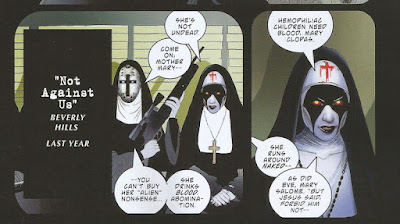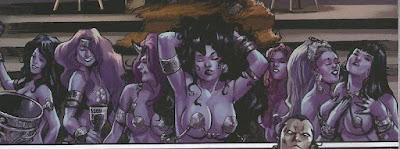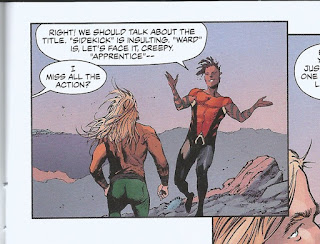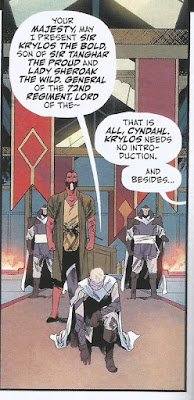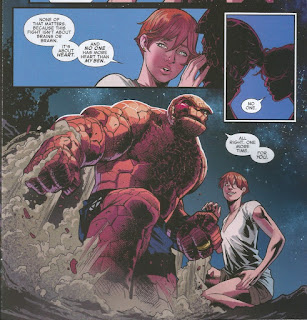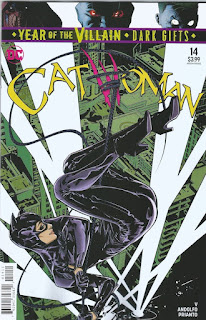Pick of the Brown Bag
August 21, 2019
By
Ray Tate
Thanks to everybody who reads the Pick of the Brown Bag, and for those who have just found this wonderful corner of the Internet, welcome. My name is Ray Tate. I’ve been reviewing comic books since the nineties. This week I look at Aquaman, Eve Stranger, Ghost Spider, John Carter Warlord of Mars Attacks, Red Sonja Birth of the She-Devil, Star Bastard, Vampirella, Wonder Woman Come Back to Me and in the Spoiler Section Batman. If you haven’t any time for the repast of reviews, check me out for a few bites on Twitter: #PickoftheBrownBag.
Eve Stranger born with an unknown medical condition. The cure repairs her. It also wipes out her short-term memory. This issue reveals the nature of the cure and some of Eve's inherent abilities.
The revelation explains how she can be batted around a bit more than the average human. A popular power for almost every hero.
The EVE Project provides Eve with the cure. In turn, they take bids for Eve's skills. Considerable and integrated with her long-term memory. The bids must be serious. The Project will not sell Eve's body, and last issue, we saw how they deal with such suggestions.
The revelation explains how she can be batted around a bit more than the average human. A popular power for almost every hero.
The EVE Project provides Eve with the cure. In turn, they take bids for Eve's skills. Considerable and integrated with her long-term memory. The bids must be serious. The Project will not sell Eve's body, and last issue, we saw how they deal with such suggestions.
Think Scanners. The serious bids are still varied. So far, Eve rescued a child from abductors. She played body guard and companion to a rich fellow fulfilling his bucket list.
As it turns out, the Project isn't hoodwinking Eve. Sure. They're getting rich off of her, but Eve needs the serum. Her father first engineered it. Amnesia is the true side-effect. His partner heads the EVE Project.
Don't mind the colors. Eva De La Cruz hued the snapshots of Eve's past in more faded tones. The colors in Eve Stranger are definitely more vibrant.
When last visiting Eve Stranger Eve began reveling in her new rocket pack. The Project tasked her to fight a giant ape.
This issue's inscrutable cover doesn't describe Eve's latest mission, which surprise is dealing with a giant gorilla.
Upon reading last issue, I thought this encounter was just a tag scene. A gag. I didn't actually think writer/co-creator David Barnett would follow through. Mind you, it's not exactly what you expect, and I shan't spoil the hilarity of the whole thing. I also like how he takes something humorous and turns it into credible science fiction drama.
When last visiting Eve Stranger Eve began reveling in her new rocket pack. The Project tasked her to fight a giant ape.
This issue's inscrutable cover doesn't describe Eve's latest mission, which surprise is dealing with a giant gorilla.
Upon reading last issue, I thought this encounter was just a tag scene. A gag. I didn't actually think writer/co-creator David Barnett would follow through. Mind you, it's not exactly what you expect, and I shan't spoil the hilarity of the whole thing. I also like how he takes something humorous and turns it into credible science fiction drama.
Of course this could all be just the dream of a small town reporter, who has chosen to seek out a therapist.
Vampirella survived a catastrophic plane crash, caused by one of her arch-enemies. Now she’s in survivor therapy recounting bits and pieces of her life to an eccentric psychologist named Daktari.
Lilith is Vampirella’s mother. Her introduction was part of V’s foray into a more Biblical translation; transmuting Drakulon into a city in Hell, or something like that. This was about ten years ago.
Lilith according to mythology was Adam’s first wife, but she appears in older religious texts as a succubus. You kind of get where Vampirella's scribes were going.
In Christopher Priest’s update, Lilith telepathically nags her daughter. I can’t help but wonder if he’s not making a joke out of the original Wonder Woman/Hippolyta relationship.
Priest is by and large known for is work in DC Comics. He’s written for Wonder Woman, expressing at least respect if not affection for the Amazon.
Vampirella features a lot of small, amusing things like the telepathic connection. These tit-bits. all add up to overall enjoyment and fit smoothly with the bigger issues.
The major scenario centers on a cult inadvertently worshipping a classic monster. The cultists think they’re discipling Satan, in an existential sort of way.
In reality, they fall victim to criminal supernatural forces reflecting the way real life cults victimize lonely vulnerable people. Vampirella isn't alone in her fight.
V originally teamed up with her lover Adam and an arch sorcerer named Pendragon. For most of the nineties however, Vampirella fought alongside of the Church’s secret monster-fighting wing. This is actually the most curious thing about the series.
One of the most recent Vampirella writers horror author Nancy Collins’ opined that The Church always intended to kill V after they had exploited her human loving sensibilities. No doubt they would deem it a mercy killing.
Priest though as you can see incorporates the different opinions about Vampirella economically within the Six Marys of the issue's title. So though this story occurred a year ago. All is not forgiven. Just some.
Daktari implies that Leader of the Mary Team may be attracted to Vampirella. She’s not the only one.
In the sixties, Vampirella fell in love with Adam. Their relationship fit with the gothic, romantic vampire tradition. Modern Vampirella stories hinted that V is bisexual. This one makes it explicit.
Warren Publishing always intended Vampirella to be for adult audiences. Certainly not children. So it’s nice to see V back to mature roots. That said. Priest and sensual illustrator Ergun Gunduz appear to be trying too prove Miley Cyrus correct:
"America's actually fine with tits, it's nipples they don't like."
No nipples were harmed in the making of these sex scenes. It's kind of silly. We can see ass, boob and Rated R lesbian scenes but not nipples? Weird.
Unlike Priest and Gunduz writer Luke Lieberman and superb artist Sergio Davila in Red Sonja do not seem to be on the same page.
That’s not fighting.
And that’s not fighting either.
A few explanations. Davila didn’t want to draw women ripping each other apart. I concur with that. Lieberman changed his mind at the last minute, or the script just wasn’t clear.
Birth of the She-Devil gives a kind of origin story to Red Sonja that’s a very soft reboot. Lieberman binds Sonja to a father figure who teaches her thievery, the art of the scam and the sword.
The addition of Ozzyus doesn't change anything. Sonja looks the same and behaves the same. Albeit she’s a bit more reckless, which is expected given her youth. This tale would actually agree with the Frank Thorne era.
Lieberman’s plot is a good one and fairly complex for the genre. Sonja is on the hunt for an old friend, taken from her by one of her adopted “father’s” associates.
Raka worships chaos. Whether or not this chaos is the same to be found in the Vampirella stories remains to be seen. V and Red Sonja will be starring as partners in their own series. So, I wouldn't be surprised if Birth of the She-Devil actually sneakily introduces the first Cult of Chaos.
Raka worships chaos. Whether or not this chaos is the same to be found in the Vampirella stories remains to be seen. V and Red Sonja will be starring as partners in their own series. So, I wouldn't be surprised if Birth of the She-Devil actually sneakily introduces the first Cult of Chaos.
Raka obviously raped Sashana. The depiction is quite clear. Given her shitty situation, I can't see how she would have been spared. Ozzyus' narration tries to downplay the violation. I see this as another disconnect between Lieberman and Davila.
Lieberman emphasizes the corruption of Sashana's spirit. The tainting of the soul is just hocus-pocus. Rape is real. It's an abomination, and Davila and colorist Ulises Arreola are justified to show the terror in the girl's eyes.
Lieberman emphasizes the corruption of Sashana's spirit. The tainting of the soul is just hocus-pocus. Rape is real. It's an abomination, and Davila and colorist Ulises Arreola are justified to show the terror in the girl's eyes.
On the flip side, Lieberman, Davila and Arreola are in synch when creating a rarity in a Robert E. Howard inspired story. A bona fide good king.
Andol is a remarkable noble contrast to the shitty chaos attacking his subjects. He looks the part, and he also acts the part. He takes the lead. He investigates. He sees a practical strategy in teaming up with Red Sonja and doesn’t try to take advantage of her like others attempted to their short sorrow.
Steve Trevor has a habit of getting lost on uncharted islands, and this year, is no different. While testing experimental aircraft equipment, Steve and his crew end up on an isle in the Bermuda Triangle that’s far from Paradise. His soulmate Wonder Woman follows in the Invisible Jet to save him.
At first this island seemed to be your typical Lost World type of locale, with dinosaurs and other prehistoric beasties, but this locale is a wee bit different.
If you’re wondering how Diana can converse with the Titan, you only need to look at her origin and the last issue of Come Back to Me. Amanda Conner and Jimmy Palmiotti remembered that Diana’s deific namesake granted her the ability to commune with the beasts.
As the story continues, more anomalies surface on the island. As well as surprising guest stars.
As the story continues, more anomalies surface on the island. As well as surprising guest stars.
Come To Me is actually set in the off-tangent DC universe in which Justin Gray and Jimmy Palmiotti brought Jonah Hex to life. This story takes place after Hex retired with fellow Bounty Hunter Tululah Black becoming sailors on a private charter. Palmiotti must have been grinning like a maniac when he realized he had already foreshadowed an explanation for Hex’s appearance.
Further exploration of the island leads to even more surprises.
Though the alien Princess appears to have amnesia, her green complexion and blonde hair combined with an affinity with technology suggest Coluan. Brainiac Five’s planet.
Artistically and in terms of cast, Wonder Woman Come Home to Me is easily one of the most vivid and diverse of the Amazon’s adventures.
Spider-Woman/Spider-Gwen officially becomes Ghost Spider as she journeys to Earth 616 to enter college. I know what you’re thinking. How on earth can Spider-Man get her a fake ID and other things. He's amazing and spectacular but not a master forger. The Iron Man movies got that covered.
Tony Stark never used to care this much about ordinary people. The movie turned him into a philanthropist in the same mold as Bruce Wayne. If you’re looking for action, you might be disappointed with this issue, as the subject of the adventurous team-up is a giant rat. Not necessarily from Sumatra.
Ghost-Spider is for people invested in these characters: the Mary Janes, the alternate J.Jonah Jameson and Captain Stacy. All have their moments, and if you're a fan of the series, you'll enjoy this laidback setup story. That said. Series writer Seanan McGuire addresses the loose ends of the previous series. Spidey comes up with a working hypothesis on why Gwen's symbiotic suit is malfunctioning. The Jackal appears at the cliffhanger and promises to make Gwen's life just as hellish on Earth-616. That's proper Marvel earth for those not in the know.
In John Carter Warlord of Martians Attack, the aptly nick-named Moon-Heads wreak over the top havoc. They make a big mistake when bringing their earth invasion to the diner where John Carter fuels up and learns of modern social advancements.
A nearby Native American hypnotist entrances John Carter to remember what transpired on Barsoom, in issue one.
Scientist Maven Keyes posits a theory that can restore the status quo.
Scientist Maven Keyes posits a theory that can restore the status quo.
This idea that Mars exists in two different quantum states is a neat idea. It banks on the Unified Theory and at once settles the conflict between the science we know of Mars, and the exotic Barsoom of Burroughs' tales.
The catalyst for the flip is John Carter himself. So, he’s the observer. When he observes Mars its Barsoom. When he’s away from Mars, it’s the red, dead planet. Mind you. Edgar Rice Burroughs didn't exactly turn Mars into an oasis like earth. He knew enough about period science to keep Mars mostly desolate.
With the plan in play, there’s still plenty of time to kill the Martians, which John Carter does with gusto illustrated by Dean Kotz. With each kill, John acquires Martian technology and instructs his new found friends on its use. Although these ships cannot be used to transport John Carter back to Mars. He must duplicate the experiment that Burroughs set up long ago. He essentially wills himself to Mars. He becomes the observer that changes the outcome.
The blue aliens of Meracorp believe they have Captain Greeves by the short hairs. What they haven’t considered is that he doesn’t possess shame.
That’s all right. Maybe they can extort his cooperation another way.
Actually Greeves isn’t all that broken up about his doll-like comrade’s plight.
Finally, Molly, who is actually the brains of the outfit acquiesces. The blue cheese hold Greeves' shipmates as collateral and sends him out to retrieve a corporate exec gone native.
When Captain Greeves, our title Star Bastard starts killing a horde of Muppet, alien gnomes with extreme prejudice, it shouldn’t be funny. Oh, but it is. Reminiscent of The Simpsons attack on jockeys.
Aquaman properly introduces the new Aqualad into the comic book. The animated Young Justice fledgling is the son of Black Manta, somehow gifted with Aqua powers.
Other than this, the sea gods begin their inhabitation of Amnesty Island, and Mera plans her wedding with another. It’s all pretty pleasant writing and drawing with the interaction between Aquaman and Aqualad funny and entertaining. As to the tease on the cover, nah.
Spoiler Section
Batman
Wow.
Okay.
Harsh.
Despite being warned off by the Batman Family and other superheroes, Damien Wayne doesn't listen. He invades Gotham City. Damien is horribly reckless and never faced the consequences of his actions. Batman changes everything for Damien.
Still, there’s several ways out of Batman where everybody ends up alive.
First and foremost, Batman isn’t actually happening. Tom King invested in several issues where Batman dreamed up and characterized associates with such detail and observational knowledge that you could have mistaken them for the real thing. Within the capacity of fiction. Batman, the real Batman, is actually imagining this entire saga as he embarks on a turning point in his life. That would piss off a lot of people.
Second, the Martian Manhunter. Batman could have deduced the tactics of his opponents to such an extent that he asked J’onn J’onnz to replace the individual in question. The person most vulnerable to his enemy's machinations. J’onn already impersonated Catwoman in Justice League of America when it looked like she was on the hook. He shifted not only into her form but her mind-set. J’onn in fact could have sealed the impersonation by blocking Batman’s memory of the request. King has yet to utilize this actual detective who frequently crossed paths with Batman. He's due for a surprise visit.
Third, there’s a new reboot heading our way thanks to Doomsday Clock or Year of the Villain. If King were knowledgable of the reboot, he may have been give extra leave to do what he wanted.
Fourth, a very obscure established alter-ego that manifests when the individual in question comes to mortal harm. Like the Hulk, the alter-ego may be able to regenerate any damage to the host personality.












